
Best opening for White after e4 e5 ?!
... people who know do, people who don't know write blog postsIntro
Hello again, from your friendly neighborhood noob!
I was playing with the Explorer stats in Analysis Board and I decided to see what is the best continuation for White after the moves 1. e4 e5. Surely the Italian or the Spanish Game would be the winners, right? Everybody and their grandparents know about these and how to play them. OK, so they are very theoretical, but people are going to win big with these two because they studied them, right?
Note that I have restricted these explorations to Standard variant that is not bullet or hyperbullet - a combination of restrictions colloquially called "chess" - and also only on games rated 1800 or higher. Why 1800? Because that was my highest rating, so anything below "noob" should be taken with a grain of salt, maybe some paprika, too.
Back to our exploration
The most played move is Nf3, followed by Nc6 and Bc4, the Italian game. The "win margin", or (white wins - black wins) / total games, for 2. Nf3 is 5.85%.
The next most played move is 2. f4, the King's Gambit, and before you stop reading and go directly to rant commenting that no one plays this anymore, I will remind you that these are stats from the beginning of the Lichess records, so from 2013 onwards. Also, for the entire database, with no restrictions on time control or rating, this one wins the most games! Yet in this context the win margin is 4.4%.
The third one is the Bishop's Opening, 2. Bc4. I remember when this was a rare novelty that people were playing to confuse their opponents. Its popularity is falling and spiking on a 5 year cycle, apparently. Anyway, the win margin is 3.95%.
OK, just one more, I promise. This one is stupid. It's the Center Game, 2. d4, a kind of reverse Scandinavian colors reversed, with an extra tempo. Moving the queen around while the opponent is developing with tempo, attacking that queen. The win margin for this is... 10.55% ?! It can't be.
2. Nc3 : 8.28%
2. d3 : -2.07% - ugh!
2. c3 : 0.45%
2. Qh5 : 7.5%
2. c4 : 2.57%
2. g3 : 2.86%
2. Qf3 : 0.4%
2. Ne2 : 2.08%
That is it! The most winning three openings, in descending order are:
- 2. d4 - the Center Game (10.55%) - played 6% of the games
- 2. Nc3 - the Vienna Game (8.28%) - played 6% of the games
- 2. Qh5 - the Wayward Queen Attack (7.5%) - really ?! - played less than 1% of the games (this one even gets a negative eval -0.14)
The rest don't even come close!
Going for the center
So let's see what this 2. d4 is about.
The most common moves go like this: 1. e4 e5 2. d4 exd4 3. c3 dxc3 4. Bc4 cxb2 5. Bxb2. It's the Danish Gambit. In this situation White wins 54% of the time.
Yet, these are not the best moves for White, let's play the best moves for White against the most common response from Black. Here, by "best" we mean the highest rated moves by Stockfish at high depth and - in case of a draw - the most winning moves statistically. With this we get the Scotch Game, Potter Variation: 1. e4 e5 2. d4 exd4 3. Nf3 Nc6 4. Nxd4 Bc5 5. Nb3. Win rate for White: 52%.
But that's Stockfish, going for the most boring lines imaginable. Let's see what happens when we play the most statistically winning moves for White. We get the Göring Gambit, Double Pawn Sacrifice: 1. e4 e5 2. d4 exd4 3. Nf3 Nc6 4. c3 dxc3 5. Bc4 cxb2 6. Bxb2. Win rate for White: 58.7% !! Will Graif knew what he was doing.
The difference between the Danish and the Göring positions, though, is just two extra developed knights on f3 and c6 and the Potter Variation can only irritate Snape.
But why?!
I think the reason why this is happening is the modern Internet chess culture. People are learning openings and catchy principles. You either play "aggressively" and "gambit style" or you go "positional" and "suffocating your opponent". One even gets to feel superior by learning stuff like "never play f3" or "always push forward".
The result is that people become specialized in certain openings and positions, memorizing the moves to get there and then playing as well as they can with the shoddy pattern recognition one gets from doing puzzles. Since their opponent is just as knowledgeable, the game becomes who can take their opponent out of book first.
That is why the most winning openings after just 3 ply are... kind of dumb.
However, that doesn't mean these opening moves cannot generate that elusive thing we all look for in chess: beauty. Say what you will about the evaluation, but the Danish, the Scotch and the Göring are flashy, poisonous and beautiful, like a femme fatale in chess form.
A beautiful line
I will not be covering any of those big three openings above. Better men than me have created a lot of related content. However, I am going to present you with a line that comes after Black does not play 3... Nc6, but the second most played move, 3... c5. This is extracted from a 3+0 Blitz game between Philosoph1974 (1880) and osseb (1832).
So 1.e4 e5 2. d4 exd4 gives us the Center Game Accepted variation. We then play 3. Nf3, the Kieseritzky Variation to which Black replies with 3... c5.
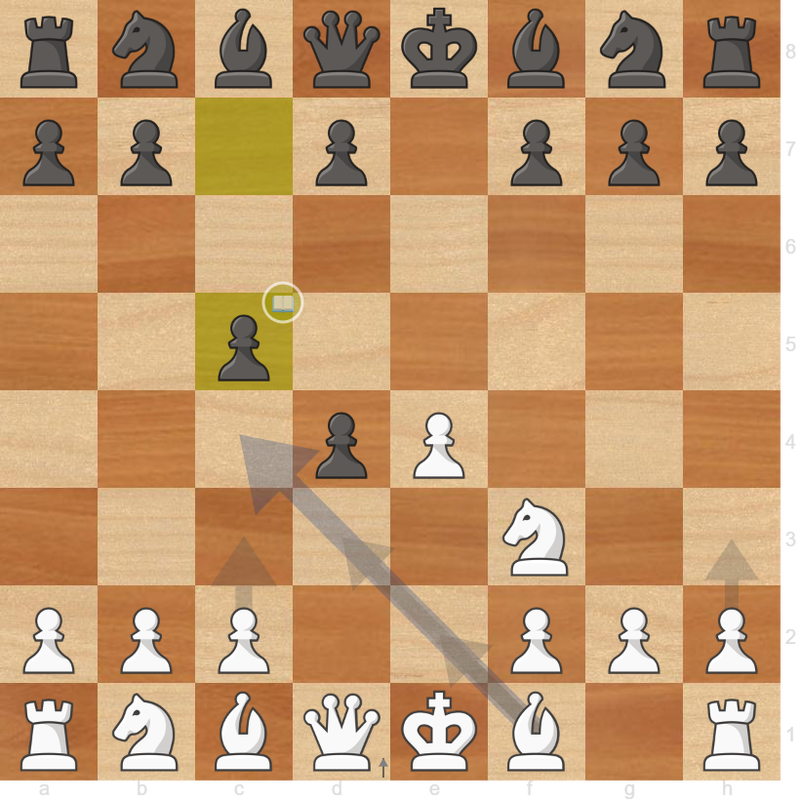
c5 is not a bad move, mind you. The evaluation jumps to 0.3 from 0.0. It also does several things: it protects the d-pawn, it opens a diagonal for the Black queen and it does not block the c6 square for the knight. It only delays Nc6, basically announcing that the Black player has ambition.
The best evaluation move in the position for White is 4. Bc4, but we're going with the most winning move, 4. c3, just like in the Danish and the Göring. Black takes and the best move in the position is knight takes, but we play 5. Bc4, because it wins more. We reach a position from which White wins in 66.6% of games, out of 40000 games. Should we name this the Omen Variation?
Black continues with their plan and moves 5...Nc6. Now, this is the third most played move in the position. The most played move is 5...cxb2, which is evaluated at 1.16 for White. The second most played move is d6, which is just as good as 5...Nc6 (0.91 eval). Let these be your homework for today. Oh, nobody likes homework... Never you mind, then.
Since Black did not capture on b2, we will capture on c3 with 6. Nxc3 and now Black blunders. They play 6...h6. It's the fourth most played move and, besides being very passive, it's not the only move that would have kept the eval to around 1. The move should have been 6...d6. Anything else is a blunder.
It's White's turn to find the best move, the one that give them +3 eval. Here is the position: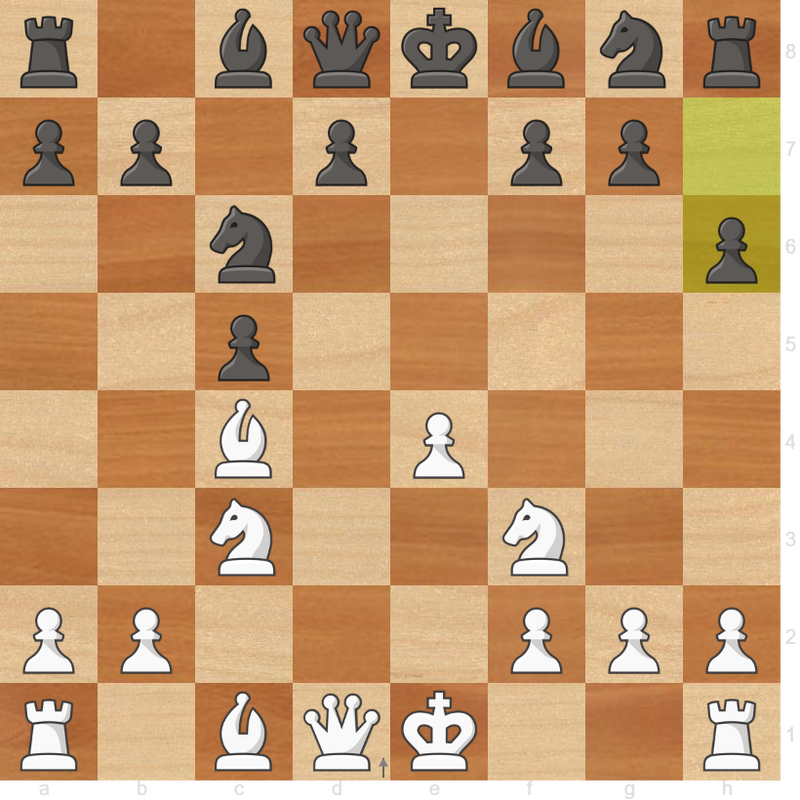
Moves until now: 1. e4 e5 2. d4 exd4 3. Nf3 c5 4. c3 dxc3 5. Bc4 Nc6 6. Nxc3 h6. What's the best move for White? And why?
Take your time. It's going to be more rewarding before you scroll to the solution.
.
.
.
.
.
.
.
.
.
.
.
.
.
.
.
.
.
.
.
.
.
.
Lichess should really implement a spoiler system in blog posts...
.
.
.
.
.
.
.
.
.
.
.
.
.
.
.
.
.
.
.
.
OK, the move is 7. Qb3. Why does it win? Hint: 7...Na5, a move that seems to hit every major White attacker and defend b7 leads to mate in 18 moves. OK, that's not much of a hint. Here is how the position looks now: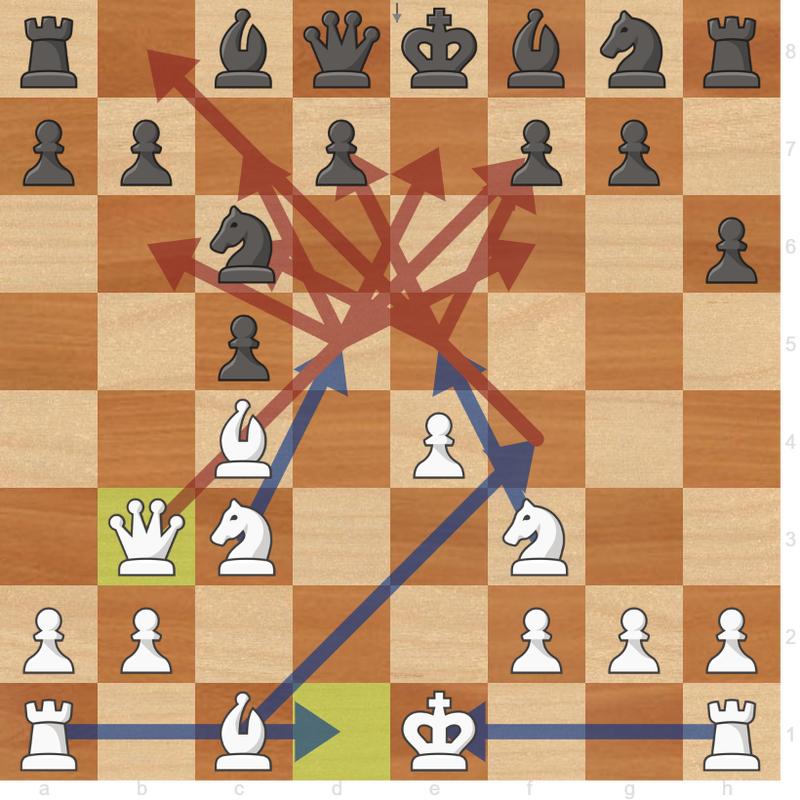
Ouch!
Every White piece except the rooks are placed for maximum effect. Black's only piece worth mentioning is the knight on c6.
Black plays the best move: 7... Qe7. White responds with 8. Bf4, bringing one more piece into the attack. Last Black blunder: 8...Nd4. Ironically, the best move now was Na5, but the eval is still +3 while Black holds to their extra pawn. That d-pawn has not moved the entire game!
See, you might not view this with as much enthusiasm as I do, but it is not clear to me why this is a winning position other than by quantifying the potential of the pieces. I don't know the exact moves, but Black's lack of development (and paralysis) and the sheer opportunity on White's side have to be winning!
That +3 eval that has been raised to +5 by the Nf4 move is not to be taken literally. It's not going to win a piece or a rook, instead the queen will die. I will give you the next moves because Black is already lost.
9. Nxd4 cxd4 10. Nd5 Qxe4+ 11. Kd2
The last move was not played in the game, instead a slightly inferior one that led to a longer continuation. After 11. Kd2 the position looks like this: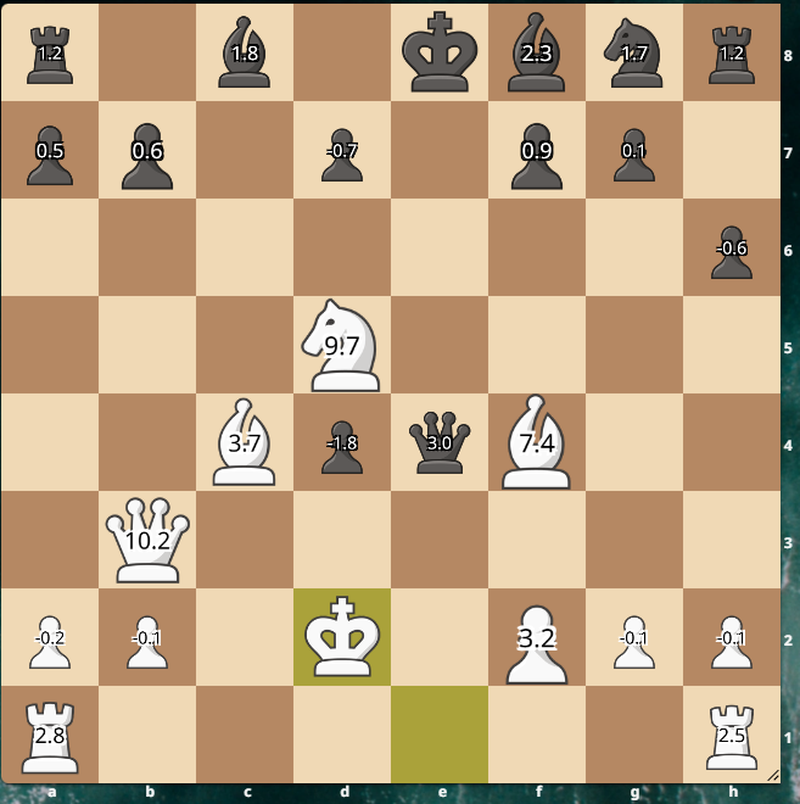
The piece values are from the /piecevalue command in LiChess Tools.
Just look at that. The center Black pawn is a traitor to its race. That queen is just as valuable as a minor piece. Black's pieces look like they're waiting for the next game on the last rank, each almost as valuable as a pawn. Meanwhile, White's centralized knight is a monster that rivals the value of the queen.
A rook is coming to e1, so the only solution seems to be Be7 or Ne7. 12. Rae1 anyway, and where does that queen go? Doesn't matter because the least important pieces of White's are the rooks. No matter what Black blocks with, White can ultimately sac a rook, then bring the other. Stockfish wants to play Qe6, a pointless move for any human, losing the queen in order to try to fix the pawn structure in front of the king. Qxg2 is almost as good and it feels as a human would play it.
The best move for White is Qb4, bringing one more piece to bear on e7. Black is lost. Let's play the wild line, with the roooooook! sacs, just for the kicks: 11...Be7 12. Rae1 Qxg2 13. Rxe7+ Nxe7 14. Re1 Qxf2+ 15. Re2 Qh4 16. Rxe7+ Qxe7 17. Nxe7 Kxe7 18. Qa3+ Kd8 19. Qc5 Ke8 20. Qe5+ Kd8 21. Qxg7 Ke7 22. Qxf7+ Kd8 23. Qf6+ Ke8 24. Bd6 Rg8 25. Qe7#
Conclusion
Heavily researched lines that bring the most minute advantages to professional players who study chess their entire lives are not as effective between regular amateur players. Instead, weird unexplored lines smash, destroy, slay and demolish (and make for YouTube content), mostly because at 1800 rating once you are out of prep you are also out of luck.
Yet these very lines bring their own style of beauty, with positions that both entertain and teach.
2. d4 followed by 3. Nf3, the Center Game: Kieseritzky Variation, is the door toward fun positions in fancy gambits, but also some very interesting lines that bring one closer to understanding the truth of chess. I hope you have fun with it.
You may also like
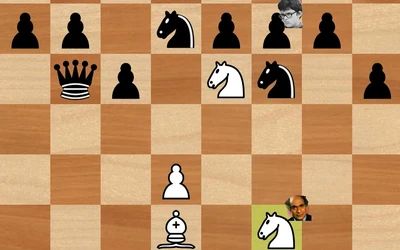 TotalNoob69
TotalNoob69Destroy the Caro Kann with style
... a beautiful line with a lot of lessons to impart TotalNoob69
TotalNoob69Analysing a single move in a very interesting position in the Closed Sicilian
... how to get more than a move and an eval from Stockfish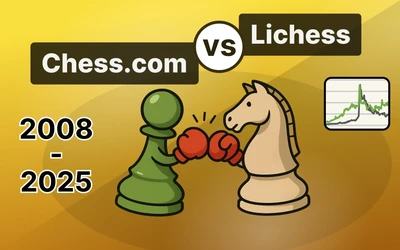 ChessMonitor_Stats
ChessMonitor_StatsWhere do Grandmasters play Chess? - Lichess vs. Chess.com
This is the first large-scale analysis of Grandmaster activity across Chess.com and Lichess from 200… CM HGabor
CM HGaborHow titled players lie to you
This post is a word of warning for the average club player. As the chess world is becoming increasin…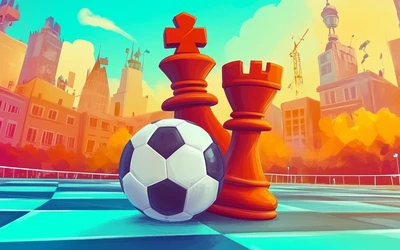 FM MathiCasa
FM MathiCasaChess Football: A Fun and Creative Variant
Where chess pieces become "players" and the traditional chessboard turns into a soccer field TotalNoob69
TotalNoob69